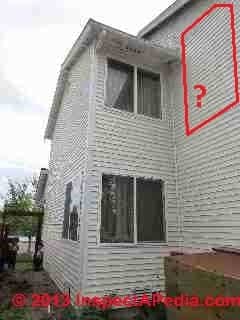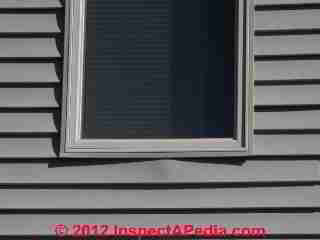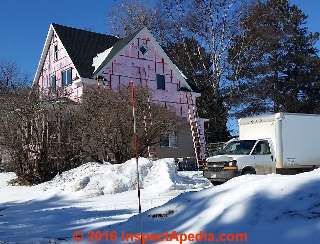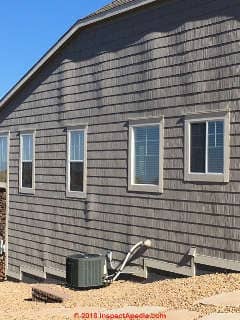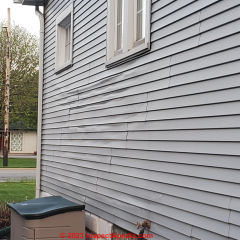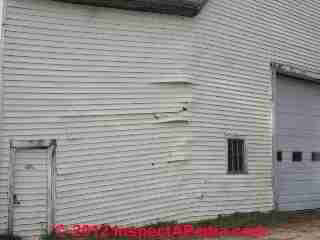 Causes of Vinyl Siding Buckled, Rippled, Bent, Loose
Causes of Vinyl Siding Buckled, Rippled, Bent, Loose
- POST a QUESTION or COMMENT about Vinyl Siding on Buildings, Installation, Inspection Methods, Defects, Diagnosis & Repair
Causes of vinyl siding damage: buckled, rippled, bent, deformed, loose, or un-clipped:
Why does some vinyl siding take on an ugly look with ripples, bends, bulges, or even loose ends?
Beginning here in an article series on vinyl siding buckling we discuss all of the know causes of this defect. Watch out: rippled or loose vinyl siding may be more than just a cosmetic worry, and may indicate structural defects, building movement, leaks, or even heat or fire hazards.
Our page top photo shows wrinkled vinyl siding - often caused by heat exposure but in this case the extent, location, pattern and size of the damage made us suspect that there was another cause, as we explain below.
InspectAPedia tolerates no conflicts of interest. We have no relationship with advertisers, products, or services discussed at this website.
Causes & Cures for Damaged Vinyl Siding: Bent, Buckled, Rippled or Sagging Vinyl Siding
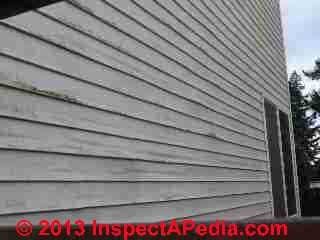 Surface distortion of vinyl siding has been recognized as a problem since the early 1960's when it was described as "oil canning" (Summers 1983). Beginning here we catalog all of the causes of and steps to cure or prevent buckled, warped, oil-canned vinyl siding as well as other forms of vinyl siding damage.
Surface distortion of vinyl siding has been recognized as a problem since the early 1960's when it was described as "oil canning" (Summers 1983). Beginning here we catalog all of the causes of and steps to cure or prevent buckled, warped, oil-canned vinyl siding as well as other forms of vinyl siding damage.
[Click to enlarge any image]
How To Sort Out the Causes of Rippled, Bent, Buckled Vinyl Siding: Product Defects, Sunlight, Heat, Installation Errors, other Causes
Reader Question: what is the probable cause of the buckled, rippled, loose vinyl siding in these photos?
First of all I would like to commend you on an excellent web site. I have considered it a valuable resource in my field of investigative engineering.
[Photos courtesy J.B. Click any image to see an enlarged, detailed version]
I was recently on your website viewing your information about vinyl siding damage and defects. I had an investigation just yesterday where I saw warped or rippled siding at a north side wall. This is a non-weathered side in Tacoma, Washington.
There is about 5’ of space between the wall and the property line fence and no utilities, etc. at that wall. There is a main floor living room and an upper floor master bedroom and that is all.
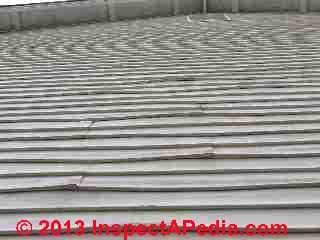 I have included some pictures for you that you may want to share on your web site and possibly comment on. There was no visible physical damage and no evidence of any water intrusion.
I have included some pictures for you that you may want to share on your web site and possibly comment on. There was no visible physical damage and no evidence of any water intrusion.
At the worst areas the vinyl siding was pulled away from the wall and there was no staining or streaking over the building paper nor was there any bubbling of the paper or damage to the OSB sheathing found.
Trapped moisture between the siding and building paper due to late fall-early spring damp weather and low temperatures is the only thing that seems reasonable at this time, except for the possibility of material defect, but I am not aware of any such defects matching the conditions seen. The residence was built in 2005. Thanks, - J.B. P.E., Auburn WA
Reply: probably defective vinyl siding product; list of other siding buckling rippling bending diagnostic questions
Without a confident diagnosis of the cause of these vinyl siding anomalies I'm reluctant to rule out anything yet, but moisture as a root cause of rippling/buckling would surprise me; I think that plastics buckle and bend more in response to heat and physical stress, or sunlight and photo oxidation than to moisture exposure.
If I had to make a guess before we know more, I'd guess a defective product, thin and poorly formulated;
We might see product defects showing up inconsistently on different building walls for several reasons: exposure differences, installation differences, even different boxes or batches of product at the jobsite.
Since it would be odd for a quantity of defective siding to precisely match the square feet of a single building side or wall, I'd expect to find either some un-damaged siding (different product) on the mostly-damaged building wall, or some damaged siding (defective product) in some areas on other walls.
According to our siding contractor Eric Galow and somewhat supported by my own field inspections, some vinyl siding may be both buckled horizontally and rippled across the vertical width of segments because of what seems to be an inferior product formulation.
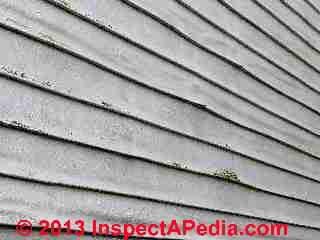 Twenty or more years ago there were (and there might be today) some lots of thin, poorly-formulated vinyl siding that warped and bent when exposed to intense sunlight or other heat sources, deforming worse than some of the more special cases we have already documented in our article series
Twenty or more years ago there were (and there might be today) some lots of thin, poorly-formulated vinyl siding that warped and bent when exposed to intense sunlight or other heat sources, deforming worse than some of the more special cases we have already documented in our article series
at VINYL SIDING INSPECTION & REPAIR
The siding in your photos seems to me to suffer multiple problems:
- it is rippled across the width of the "board" segments (a heat and formulation problem most likely), and
- ends have come loose and curled
- the clip-on bottom edge of the siding segments failed to remain clipped in position.
Although you have not yet seen water damage, leaks can be a bit subtle and even hidden unless the siding is removed entirely.
So it may remain possible that this condition is more than a cosmetic defect; loose siding risks leaks into the wall structure, inviting rot, insect damage, possibly even mold contamination; and the risk of wind blow-off of siding areas is of course much increased.
Siding Damage, Buckling, Distortion Diagnostic Questions or Observations
As a technical aside, and certainly not having to do with the root cause of this badly rippled, loose, buckling vinyl siding, in the photo at left (click to enlarge) I see what looks like "more clean" vertical sections of wall siding in the upper right quadrant of the picture. There may be an insulation void or other interesting building condition going on there.
It would be diagnostic in confirming that the root cause of this siding damage is defective product if we could rule out other factors; Some of these vinyl siding damage factors are adapted from Cardinal (2016), cited below.
- Reflected heat: the position of the sun or relationship of the angle of nearby windows,
wall where siding is damaged, restriction of damage to only areas where there is reflected heat - see details
at VINYL SIDING DEFORMED by SUNLIGHT - The age of the building (2005 in this case, or about 8 years old).
Eric Galow notes that following Hurricane Katrina (also 2005) not only were many common building products in short supply, but the price of building products using petroleum products increased significantly.
We also SPECULATE that around the same time there may have been batches of hastily-produced and defective building products including siding and roofing materials.
Cumulative time and temperature effects on vinyl siding can contribute to buckling. - The estimated age of the siding (2005 in this case) -
and can we assume that this is the original siding? Probably. - Where the siding was purchased
and thus tracing back through that supplier, who made it. - Siding thickness and chemical properties:
siding age, manufacture, brand name, model, any markings on reverse side, and actual siding thickness can explain product failures.
We have noticed particular generations or batches of vinyl siding prone to cracking, breakage, color fading, and surface chalking as the vinyl siding weathered; - The geographic location & climate
where the building is located - The temperature and weather conditions when the siding was installed,
and the temperature and weather conditions when the buckling vinyl siding is most-evident.
Other useful diagnostics for this siding buckling, rippling, and loose ends all found in one place would include:
- Is the siding equally damaged on all sides of the building
or is the problem worse only on one particular side - the North side per your original note?
Look for more siding buckling where the siding is exposed to more sunlight, more heat, and for the effects of wind on the siding (cooling, or loosening and mechanical damage).
You indicate that damage is just on one side, the North face - confirmed by your photos and emphasized by the presence of some algae on the siding surfaces. Since North is not the sunny side for buildings in North America, what other site conditions are different for this building side?
Examples might be different product installed, reflected heat from another nearby building wall or glazing, chemical exposure, prevailing wind, even simply different installation practices by an individual worker or team from those installing siding on other building walls.
Architectural designs that block wind and trap heat (e.g., overhangs, alcoves, inside corners) will affect which areas of siding tend to become more-distorted, as can a design that causes reflected heat onto specific ares of vinyl siding, such as from opposing windows.
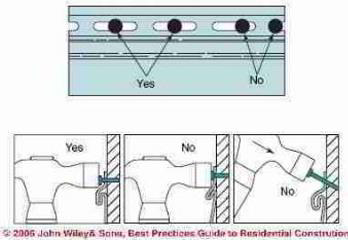
- Is the siding nailed too tightly
(it should be hung, not nailed tightly, and we should be able to slide segments horizontally 1/2" or more)
See VINYL SIDED WALL THERMAL MOVEMENT
see VINYL SIDING NAILING GUIDELINES - What is the thickness and condition of the building sheathing to which siding is nailed?
Did nails simply pull out? This would not explain siding buckling, or rippling but can contribute to loose flapping siding or siding ends at butt joints. - Was the siding placed properly when it was nailed in the first place?
If the siding was pushed upwards too tightly, clamping very tight on the connecting lip of each siding segment below it might have encouraged stretching then warping and loosening due to subsequent heating;
This is a bit speculative, but there is no question that structural stresses can deform vinyl siding - as we illustrate
at VINYL SIDING MOVEMENT DAMAGE
Depending on how siding is cut (e.g. failure to allow space for thermal expansion) can cause installation strains that cause or contribute to buckling, possibly exacerbating manufacturing related strains from the siding's production. - Housewrap:
Regarding "nor was there any bubbling of the paper" - was conventional housewrap installed behind the siding or some other building paper or nothing?
Housewrap won't explain rippled buckled siding but relates to moisture control and building leaks. - Was this siding ever removed and re-installed on the structure?
(look for old nail holes, nailing flange damage, etc) - Siding performance compared with other siding installations
in the same area, of similar age, same contractor:
Are there other buildings constructed in the same area, at the same time, or by the same contractor whose siding shows similar damage?
This can point to a more extensive use of defective product, or in some cases the same siding installation crew making the same installation errors on multiple buildings. - Siding chemistry:
Heat distortion temperature of the vinyl siding may vary not only by brand and product but possibly between siding production runs.
Variations in siding molecular strains can be "frozen" into specific siding products during the manufacturing process, making a particular siding product or production run prone to distortion when exposed to sunlight, heat or other external factors. - Siding color and solar absorption -
darker colors, more solar heat absorption - Siding environment:
siding distortion will be significantly affected by the ambient outdoor temperatures to which the vinyl siding is exposed, particularly when exposed to high temperatures (expansion, buckling, warping) and possibly when exposed to very low temperatures (shrinkage, warping, cracking depending on how the siding was fastened).
Exposure of the vinyl siding to wind affects the cooling of the siding and may be a factor in explaining why siding is distorted more on one side of the building than another.
- Siding exposed to specific heat sources: barbecues, motors, etc.
the proximity of vinyl siding to point- heat sources, such as barbeque grills or fire pits, and possibly closeness of vinyl or other plastic siding to other heat sources, such as air conditioning compressor units, electrical generator motors or other mechanical systems or equipment.
See examples at
at VINYL SIDING FIRE DAMAGED
and VINYL SIDING GRILL COOKER DAMAGE
Reader Follow-Up:
Thanks! My opinion is that it may likely be indirect heat reflecting from an upper floor window of their neighbor’s house which faces the damaged siding. The siding damage is between the upper floor and stops about 5’ above ground so it is at a specific location.
The somewhat widespread uniform warping would seem to indicate it is not a material defect.
If I get permission to check the manufacturer I will let you know. Thanks for your input and I agree that we all learn from each other’s collective experience, etc. - J.B.
Reply:
Very interesting;
I must have missed that option in our correspondence.
There is no doubt that reflected heat from sunlight can cause rippled damaged vinyl siding - as I show at
the page top photo
at VINYL SIDING INSPECTION & REPAIR and at
at VINYL SIDING DEFORMATION) (which you may have already seen)
It would be useful to
- photo document the site, the relationship of the building wall and opposing windows, and
- to measure the distance between the surfaces and to
- project the pattern of reflected heat from opposing windows on an adjacent building to see if the siding buckling or rippling maps those areas
- If you've got an IR or other thermal scanner you could also make some interesting measurements in and out of the reflected heat areas on the receiving building wall.
In the case of window-reflected heat I've already documented, the distances were short, there was some protection from wind and air movement, and ultimately we could practically "see" the pattern of damaged vinyl siding matching exactly the parallelogram of a distorted window shape effected by the angles involved.
Nice going.
Buckled Vinyl Siding due to Thermal Expansion & Improper Nailing
Vinyl siding will buckle due to thermal expansion if it is not properly installed. Properly installed vinyl siding here means proper placement of siding nails, not over-nailing too tightly, and allowing proper end clearance at single-piece siding runs to allow for thermal expansion.
Vinyl siding that buckles due to improper nailing (photo shown above) is is not normally extremely wrinkled, and will be more wavy across longer horizontal runs of surface
And of course, more severe buckling vinyl siding will be found on a building sides more exposed to sunlight.
Experienced vinyl siding installers who want to avoid siding blow-off refer to "hanging vinyl siding" on the building wall rather than "nailing vinyl siding to the building wall" precisely to remind workers not to nail siding so tightly that it buckles when heated.
See details at VINYL SIDING INSPECTION & REPAIR
On a wall section long enough to have spliced sections of vinyl wall siding in a given siding course, if we see vinyl wall siding that is buckled, we also check to see if the siding moves freely left and right on the wall.
It's easy to either use the butt of your hand to try to slide a siding panel left or right - it should move about 1/2" or so. If the siding feels tight we may check further by grasping the end or edge of a siding section to see if we can pull or push it.
When locking the vinyl siding panels into position, do not force them up or pull them down to adjust the alignment.
Too tight panels can tear and too-loose panels can unlock and come loose. One exception is at the band joint between the first and second floor where panels may come unlocked due to shrinkage of the framing. To compensate for this, some contractors pull the panels a little tight over the band joist area.
Range of Temperature Exposure of Vinyl Siding
At THERMAL EXPANSION of MATERIALS where we discuss the coefficient of linear expansion of many materials we note that vinyl siding can expand significantly along its longer length in response to temperature variations. Consider the vinyl siding installation shown in-process just below.
A crew of four workers was installing vinyl siding on this home in Two Harbors Minnesota in late February, 2016. The workers noted that when they started hanging siding early in the morning the outdoor temperatures were close to 0 °F and there was a biting wind to boot.
Considering that on a hot summer day the temperature on the surface of sun-exposed sides of this home may easily reach 100 °F the siding is exposed to temperature swings of 100 °F or more! Unless the siding is properly hung on the building, buckling of this material in hot weather would be no surprise.
Detailed specifications for hanging vinyl siding to avoid buckling and blow-offs are found in our
article VINYL SIDING INSTALLATION - see:
- NAILING GUIDELINES for Vinyl Siding - Mistakes mean Blow-Off or Buckling Siding
- OVERLAP SPECIFICATIONS for Horizontal Vinyl Siding Joints
- SOFFIT & FASCIA PRODUCTS Used with Vinyl Siding
- THERMAL MOVEMENT in VINYL SIDING - improper nailing, no caulking
Coefficient of Linear Expansion of Vinyl Siding
Above: badly-buckled siding on a building, photo provided by an InspectApedia.com reader. We're not sure what this siding material is: possibly plastic or pvc. I suspect this siding was installed without proper spacing allowance for thermal expansion.
Special thanks to Bob Fankhauser <blueboxconst@hevanet.com>, a retired engineer / professional handyman and Habitat for Humanity volunteer who offered comments, suggestions, additions for vinyl CLTE (Coefficient of Linear Thermal Expansion), CPVC, PVC, cellular PVC, and vinyl (25 Feb 20-16) as well as helpful discussion concerning the wide variation in coefficients of expansion of materials given by various sources.
Vinyl siding can expand and contract 1/2” (12.7mm) or more over a 12’ 6” (3.81m) length during normal, year-round changes in temperature. That's quite a bit, and we think that metal siding will have an even greater coefficient of thermal expansion. - VSI Cited where we discuss proper siding installation, including the importance of "hanging" the siding on the wall, not "nailing" the siding to the wall,
See the examples quoted at note 1 below.
1. PVC has a glass transition temperature (Tg) of about 165 F, and a coefficient of thermal expansion (CLTE) of about 3.5x10 -5 " - source: Stucky, David J., Randall M. Elinski, and Lori M. Hesslau. "System, method and apparatus for dark-colored siding panel product." U.S. Patent 9,145,690, issued September 29, 2015.
- PVC, cellular, 4.5 x 10-5 in/in/F" for rigid PVC & "3.2 x 10-5 in/in/F - source: "Versatex Trimboard", http://versatex.com/PDF/D-1_Physical_Properties.pdf (2016/02/24)
- PVC, cellular, 28 x (10-6 in/(in R))*) - source: http://www.engineeringtoolbox.com/linear-expansion-coefficients-d_95.html (2016/02/24)
2. Vinyl siding has a high Coefficient of Linear Thermal Expansion (CLTE) as discussed in some of the citations given just below.
For this reason siding manufacturers include long nailing holes and instructions to hang (loosely) rather than "nail" (tightly) vinyl siding to the building and to provide both overlap between siding sections and end or butt-joint clearances.
Research on Vinyl Siding Distortion or Buckling: Causes, Prevention, Cure
- THERMAL EXPANSION of MATERIALS a table of CLTE values for common building materials
- VINYL SIDING DEFORMED by SUNLIGHT
- Andrady, Anthony L., S. H. Hamid, X. Hu, and Ayako Torikai. "Effects of increased solar ultraviolet radiation on materials." Journal of Photochemistry and Photobiology B: Biology 46, no. 1-3 (1998): 96-103.
Abstract excerpt::
Synthetic polymers such as plastics, as well as naturally occurring polymer materials such as wood, are extensively used in building construction and other outdoor applications where they are routinely exposed to sunlight.
The UV-B content in sunlight is well known to affect adversely the mechanical properties of these materials, limiting their useful life.
Presently their outdoor lifetimes depend on the use of photostabilizers in the case of plastics and on protective surface coatings in the case of wood. - Beck, David H., Robert D. Shaw, and David J. Stucky. "Temperature-expansion indicator for siding panels." U.S. Patent 6,939,036, issued September 6, 2005.
- Cardinal IG, VINYL SIDING DISTORTION [PDF] (2016) retrieved 2018/08/19, original source: https://www.cardinalcorp.com/source/pdf/tsb/ig/IG14_01-2016.pdf
Good luck trying to find the company's contact information and mailing address on their website. The address may be: Cardinal IG Co, 50 Elmwood Ave, Mountain Top, PA 18707 USA - Ed.
- Hendrickson, Gerald L., Kurt E. Heikkila, Timothy P. Murphy, and Maurice N. Goeser. "Fiber-polymeric composite siding unit and method of manufacture." U.S. Patent 6,122,877, issued September 26, 2000.
- Kellis, Warren D., Daniel King, and Lyle Rice. "Plastic siding mounting system." U.S. Patent 4,669,238, issued June 2, 1987.
- Kendall, James R., "Vinyl siding bracket." U.S. Patent 3,458,962, issued August 5, 1969.
Excerpt:
Rigid vinyl and similar thermoplastic materials or even aluminum have a high coefficient of thermal expansion, relative to conventional building materials, such as wood, steel and the like.
For example, in warm climates during the summer months, sidings can easily reach an extreme temperature of 120 F., and it is not at all uncommon for siding to be installed during a winter at temperatures of 20 F. or even below.
Where such extreme temperatures are involved, a temperature differential of at least 100 can very definitely occur, and in the case of a foot vinyl siding, a thermal expansion and contraction of at least one-half inch would occur. - Mowery, Jack T., and Benjamin L. McGarry. "Splicing member for siding panels." U.S. Patent 6,393,792, issued May 28, 2002.
Excerpts:
Another problem encountered in the installation of siding panels is their rate of expansion and contraction. Vinyl siding panels have a relatively high thermal coefficient of expansion, on the order of 4.5×10 −5. Therefore, for a typical 12′ long panel, there can be a variance in its length of up to ¾″. - Patterson, John, and Gene Szamborski. "Expanding PVC as a building material." Journal of Vinyl and Additive Technology 1, no. 3 (1995): 148-154.
- Rabinovitch, Elvira B., and James W. Summers. "The effect of physical aging on properties of rigid polyvinyl chloride." Journal of Vinyl Technology 14, no. 3 (1992): 126-130.
- Rabinovitch, Elvira B., and James W. Summers. "Weather resistant plastic composites capped with polyethylene terephthalate glycol (PETG) for outdoor exposures." U.S. Patent 6,855,402, issued February 15, 2005.
- Stucky, David J., Robert D. Shaw, and Stephen W. Steffes. "Siding panel tab and slot joint." U.S. Patent 7,207,145, issued April 24, 2007.
- Summers, James W. "Formulations for vinyl house siding: History, present, future." Journal of Vinyl Technology 5, no. 2 (1983): 43-46.
This article notes that plasticisers added to improve vinyl siding impact resistance also increase its coefficient of expansion.
Vinyl Siding Deformation Reflected Sunlight & Heat from Nearby Surfaces,
This topic has gotten fat - we moved its tubby self over to its own room
at VINYL SIDING DEFORMED by SUNLIGHT
Buckled Rippled Vinyl Siding Caused by Combined Factors: Heat + Nailing ?
Continuing the case of vinyl siding deformed by sunlight or reflected sunlight, siding that's rippled and damaged perhaps by a combination of factors is discussed
at VINYL SIDING BUCKLED RIPPLED COMBINED EFFECTS?
Buckled or Sagged or Rippled Vinyl Siding due to Point-Source Heat Damage - Barbecue Grill or or Heat Source
Please see the new home for grillers who cook their siding: VINYL SIDING GRILL COOKER DAMAGE
Fire-Damaged Vinyl Siding Photos
This hot topic got a page of its own, now at VINYL SIDING FIRE DAMAGED
Vinyl Siding Buckled, Torn Due to Building Movement
This topic has been moved to VINYL SIDING MOVEMENT DAMAGE where serious structural damage is suggested.
Reader Comments, Questions & Answers About The Article Above
Below you will find questions and answers previously posted on this page at its page bottom reader comment box.
Reader Q&A - also see RECOMMENDED ARTICLES & FAQs
On 2023-04-02 by InspectApedia Editor - improper installation or leaks can lead to buckling
@Amy,
No worries, we will upright your photos when they migrate up onto a web article here for preservation.
But that is NOT vinyl siding in your photos. It's hardboard or fiberboard siding.
See
SIDING HARDBOARD - home - wood-fiber based siding products
https://inspectapedia.com/exterior/Hardboard_Siding_Guide.php
If it was improperly installed that can cause the buckling in your photos, as can leaks that wet the material from its back side.
On 2023-03-31 by InspectApedia Editor (mod) - original siding has been painted twice and now buckling not due to window replacement usually
@Amy,
I would have to see the buckled siding and its relationship to the location of the window to be confident of an answer - perhaps you can post a photo of the situation.
But in general, where siding is left undisturbed when replacing windows, that work shouldn't be a factor in siding buckling.
More likely it's one of the causes discussed above on this page.
Keep in mind that painting vinyl siding is possible but not a common procedure. You're replacing a relatively maintenance-free surface with paint that will require maintenance & re-painting. So I wonder if there was a problem with this siding in the first place.
Also, if you painted your siding a darker than original color, that increases its heat absorption which would invite buckling. Usually the wall that gets most sun (usually South not North) is what would buckle first.
On 2023-03-31 by Amy
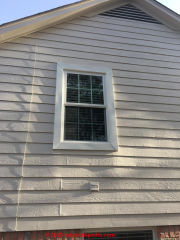 My home was built in 2001 and has original siding and has been painted twice. We replaced the windows and on one side, where the window was replaced, shortly thereafter the siding has begun to buckle. It is a north facing wall.
My home was built in 2001 and has original siding and has been painted twice. We replaced the windows and on one side, where the window was replaced, shortly thereafter the siding has begun to buckle. It is a north facing wall.
Would this be the result of the window replacement? There is no water leakage in the inside of the home from this window. Or was this simply coincidence due to age?
This is a picture of the buckling side on my house. For some reason it uploaded sideways. The guy that installed the window said our siding was made of "paper" rather than vinyl. Pella installed the windows and they have come out to do an inspection of the buckling.
We are waiting to hear back from them but in the meantime wanted to see what you thought.
On 2022-02-25 by Inspectapedia Com Moderator - can I have my builder pay for the siding and labor to repair warped siding?
@Janice Estes,
Short answer: probably not as your home is 5 years old. In South Carolina, a building contractor is responsible for the quality of her work for three years after the original job.
But beyond that simple point, some further inspection by an on-site expert, someone without bias, can diagnose the cause of buckling siding, such as those described above on this page.
You will read in the article above that some siding may buckle from heat or even sun exposure even if it's properly installed, while
other types of buckling in vinyl siding may be caused by improper nailing (too tight) onto the wall.
On 2022-02-25 by Janice Estes
My home is 5 years old. The siding on the North side of my house warped and ripple. I live in South Carolina can I have my builder pay for the siding and labor under the laws of SC.
On 2021-10-22 by inspectapedia.com.moderator - Brand new siding and it has ripples
@Carmen,
1. Rippled vinyl siding won't "go away" on its own
2. You need an accurate diagnosis by an independent siding installer/expert or experienced home inspector who can help distinguish between 3 probable causes, listed in order of probability:
- siding is nailed too tightly (if you can't slide individual sections side to side it's improperly nailed) or occasionally, was cut too long and is too tight at siding end-butts against its J-channel or other vertical building trim;
- siding is rippled from heat exposure (more rippled or wavy where there is more sun exposure)
- siding was defective from the factory
Too-tight: it may be possible to remove and reinstall or even just loosen the siding - depending on installation details.
Heat-rippled: it'd need replacement.
Identify your siding brand and model and get your own copy of the manufacturer's installation instructions.
Read them and compare those details to your specific installation.
Post some photos (one per comment) for us to see too.
On 2021-10-22 by Carmen
We have BRAND NEW siding and it has ripples. The contractor called it oil canning. We called it unacceptable. The manufacturer is blowing smoke up our rear ends and making it sound like its perfectly normal and it will go away on its own. We have been arguing for 3 months.
It hasnt changed at all in spite of dramatic temp changes. Are we correct in demanding it be fixed?
On 2020-07-14 by danjoefriedman (mod)
I'm puzzled and been reduced to guessing Just As You Are. I tend not to think that it's defective product because if that were the case I would expect this rippled vinyl to show up and more areas rather than being localized on the house.
I don't quite follow the asphalt driveway suggestion unless you think that there was recent asphalt work done immediately below that area. I have seen similar localized rippled vinyl siding on building where there was a local contaminant source.
Last year I also found such a building that had rippled siding where an oil tank has been removed. So you might be looking for a source of a contaminant liquid or gas. You might also want to rule out source of problem inside the wall of the building by checking and letting me know what is located on the other side of that wall.
On 2020-07-14 by Tracy B
What would that be from? Asphalt driveway? Otherwise, house next door (other side of our driveway) has no issue with their siding. Their side gets more sun, as the sun runs on the opposite side (of damage) of our house. Quite a conundrum.
On 2020-06-06 by danjoefriedman (mod)
Any chance of reflected heat?
On 2020-06-04 by Tracy B
@danjoefriedman,
Thanks for the input, but.. No.. no painting, no solvent used and definitely a new phenomenon. Very frustrating! Guess I need to have a pro come look at it?
On 2020-05-12 by danjoefriedman (mod)
Tracy
That certainly looks as if a solvent has affected the vinyl siding on your home. Are you absolutely certain that this is a new phenomenon that just started? Has the siding been painted or has it been treated with a cleaner or chemical agent of any kind?
On 2020-05-11 by Tracy B
my house was built in 1925, Sears home, plaster walls. I have lived here 12 years, uncertain when siding was put on, but it was NOT new when I moved in. Sun does not hit this side of house, no heat source near it (inside or outside).
Kitchen sink is under larger window, dining room/nothing behind/under smaller window. Located in NW Indiana. Upstairs shower is on OTHER side of the house. Just started seeing this in last few months, its the only area of siding that looks this way. Any ideas?
On 2020-02-26 - by (mod) - white, round circles are appearing all over the exterior of the siding
Jim,
Please use the add image button to attach a photo showing the spots that you described.
Also tell me if they are occurring uniformly all over the home or if they are more frequent on one side.
I suspect that you are seeing spots at nailheads just as you described.
The cause may be something as simple as slight differences in temperature of the surface at the nail heads that in turn cause spot condensation in certain weather conditions that in turn affects the siding color.
Tell me also if the spots are constant or if in warm dry weather they diminish or disappear
On 2020-02-25 2 by Jim Gately
My vinyl sidding is grey in color and was installed 15 yrs ago with a lifetime warranty. This last year white,round circles are appearing all over the exterior of the sidding. The circle appear to have something to do with the nail heads underneath the sidding as they are in straight rows etc. What is causing this and will my warranty cover it??
On 2020-01-11 - by (mod) - buckling siding diagnostic questions
Richard, I'd need to know more and see more to understand why the bottom vinyl is buckling.
Since siding is installed from the lowest course upwards on the wall, buckling at the bottom would normally be traced to either pressure from above or pressure from below.
From below, for example, if siding is nailed over a wall set on rotting wooden framing or a settling foundation, the siding may press against the ground or against a masonry foundation top (if it's wood rot) and then compress.
How old is the home?
How is it constructed: materials, above-ground clearance; ?
Is there a basement or crawl space that gives view to the other side of the wall?
Perhaps you could use the add image button to post some photos (one per comment)
On 2020-01-11 by Richard grigor
New vinyl siding section at bottom of wall distorted.Then it was replaced. Four days later same thing.Could it be because foam board under it was defective.Or was it nailed to tight?
On 2019-12-05 - by (mod) - troubles with incomplete work by siding contractor
Nancy
I want to help but I can't understand enough of your situation from what you've written so far.
1. "Wrapped?" what was going on, what was proposed? Wrapping what with what material for what purpose?
2. "Wrapping only edges" - edges of what - each siding board? corners? With what material? for what purpose?
3. Siding sliding sideways? - how far, why, what was done to the siding to cause it to move. (Properly installed siding is hung-on, not nailed-to, a building. It can move sideways as much as the width of the slot through which nails are secured. No more.
Horizontal siding would terminate in corner trim installed at the building corners, a vertical piece; were those removed and left off?
Try using the "add image" to add some photos - one per comment; the photos will appear after moderator approval and perhaps we can comment further.
DO NOT pay the company anything until you are completely satisfied.
On 2019-12-05 by nancy
Approximately 15-20 years ago, we had aluminum siding, as did our entire neighborhood. After a heavy hail storm, we,and many of our neighbors, had our siding replaced w/vinyl siding. We've never had any problems w/our siding.
During this past summer, we had our house wrapped and a few windows replaced by what we thought was a reputable company, Thompson Creek. We have had numerous problems w/them. On the southwestern side of our house, the wall is entirely siding, the one window had been replaced years before.
They wrapped only the edges of the siding. Since that time (the job was finished in August), we had 2 instances where the siding slid sideways, exposing the house underneath,
They came out twice, the second guy saying that he'd secured the siding so that it wouldn't slide again. When he first looked at the problem, he said that they didn't need to fix it because they hadn't installed the siding. When I mentioned that they had wrapped the wood on the edges of the siding, he agreed to fix it.
The third time the siding came loose was during a heavy wind storm. Not only did it come loose, but this time, it broke completely away, bent away from the house. They sent a more senior guy out this time (we thought they were coming to fix it, but he came in a truck w/out tools, like the others had), which surprised me because we thought they would fix it like before.
This guy said that they were not responsible; that wrapping the area around the ends of the siding could not cause the siding to be jarred loose.
Is that true? We don't want to hassle the company if it's not their fault, but now, in order to match the siding, we'll have to replace the entire wall, at a cost of $5-7,000.00.
We are both 66 yrs. old, and we're not rich. We had a contractor come out tonight to give us an estimate, and he said it was possible that Thompson Creek had created the problem. My husband is so disgusted w/the company, that he doesn't want to deal w/them anymore, but I just want to know if it's worth pursuing their liability. We don't just happen to have a spare $7,000.00 lying around.
Any info or opinion you could give me would be greatly appreciated. Nancy love
On 2019-05-31 - by (mod) - matching replacement siding
That generosity would surprise me.
On 2019-05-30 by Anonymous
If only one side of a 4 sided house has damaged vinyl siding, should your homeowners insurance pay for 4 new sides to match equally
On 2019-05-23 - by (mod) -
Anonymous by private email said
I live in a 55+ manufactured home community in the Orlando, FL area. We were hit by Hurricane Irma on 9/10/2017. Our home, as well as others, had some of the vinyl sidings detach and hang or appear to be okay but was actually loose. We are currently in litigation with the insurance company for moisture damage to our subfloor from the rain entering through the detached & loosened vinyl siding.
I have noticed the vinyl siding warping and buckling on my home and a majority of the homes in my community. This has just started happening in the recent past few months. Could this be caused by the hot Florida sun in combination with moisture trapped behind hurricane loosened/detached vinyl siding?
The majority of our residents live on Social Security and can not afford expensive repairs. Who would we contact to inspect this situation and advise if this is hurricane damage that should be covered by our insurance companies? Also, who could I contact to inspect and confirm the subfloor moisture damage in my home? I also have black mold in the kitchen wall.
Thank you for any recommendations and assistance you can provide. Im sure our community isnt the only one experiencing this damage.
Moderator reply:
Siding that warps or buckles is usually doing so from being nailed too tightly; much less often it's a defective product; in that case I'd expect the condition to show up before the Irma storm.
Please take a look at VINYL SIDING BUCKLED WARPED and let me know if that leaves you with questions. https://inspectapedia.com/exterior/Vinyl_Siding_Buckled.php
On 2019-03-11 - by (mod) - nearby water causes buckled siding?
Thanks for an interesting question Bill.
I suppose it's theoretically possible that a dead flat body of water close enough and on the right angle could affect vinyl siding, but it seems unlikely that those conditions would occur.
On 2019-03-08 by bill
will a big lake cause siding and trim to warp?
...
Continue reading at VINYL SIDING DEFORMED by SUNLIGHT or select a topic from the closely-related articles below, or see the complete ARTICLE INDEX.
Or see VINYL SIDING BUCKLED WARPED FAQs - questions & answers posted originally at the end of this page.
Or see these
Recommended Articles
- SIDING VINYL - home
- VAPOR BARRIERS, VINYL SIDING
- VINYL SIDING BUCKLED RIPPLED COMBINED EFFECTS?
- VINYL SIDING BUCKLED WARPED
- VINYL SIDING COEFFICIENT of LINEAR EXPANSION
- VINYL SIDING CLEANING METHODS
- VINYL SIDING CLEARANCE TO GROUND
- VINYL SIDING DEFORMED by SUNLIGHT
- VINYL SIDING FIRE DAMAGED
- VINYL SIDING GAPS, HOLES, CRACKS
- VINYL SIDING GRILL COOKER DAMAGE
- VINYL SIDING HOOK to REMOVE & REPLACE
- VINYL SIDING IMPACT DAMAGE
- VINYL SIDING INSPECTION & REPAIR
- VINYL SIDING INSTALLATION
- VINYL SIDING INSTALLATION MANUALS
- VINYL SIDING INSTALLATION PROCEDURES
- VINYL SIDING LEAKS
- VINYL SIDING LOOSE, BLOW-OFFS
- VINYL SIDING MOVEMENT DAMAGE
- VINYL SIDING STAINS
- VINYL SIDING STAIN CLEANING METHODS
- VINYL SIDING or WINDOW PLASTIC ODORS
- VINYL CHLORIDE HEALTH INFO
Suggested citation for this web page
VINYL SIDING BUCKLED WARPED at InspectApedia.com - online encyclopedia of building & environmental inspection, testing, diagnosis, repair, & problem prevention advice.
Or see this
INDEX to RELATED ARTICLES: ARTICLE INDEX to BUILDING SIDING
Or use the SEARCH BOX found below to Ask a Question or Search InspectApedia
Ask a Question or Search InspectApedia
Questions & answers or comments about Vinyl Siding on Buildings, Installation, Inspection Methods, Defects, Diagnosis & Repair.
Try the search box just below, or if you prefer, post a question or comment in the Comments box below and we will respond promptly.
Search the InspectApedia website
Note: appearance of your Comment below may be delayed: if your comment contains an image, photograph, web link, or text that looks to the software as if it might be a web link, your posting will appear after it has been approved by a moderator. Apologies for the delay.
Only one image can be added per comment but you can post as many comments, and therefore images, as you like.
You will not receive a notification when a response to your question has been posted.
Please bookmark this page to make it easy for you to check back for our response.
Our Comment Box is provided by Countable Web Productions countable.ca
Citations & References
In addition to any citations in the article above, a full list is available on request.
- Bob Fankhauser <blueboxconst@hevanet.com>, 503 206 9824 Cell, a retired engineer / professional handyman and Habitat for Humanity volunteer who offered comments, suggestions, additions for vinyl CLTE (Coefficient of Linear Thermal Expansion), CPVC, PVC, cellular PVC, and vinyl (25 Feb 20-16) as well as helpful discussion concerning the wide variation in coefficients of expansion of materials given by various sources.
- Steve Bliss's Building Advisor at buildingadvisor.com helps homeowners & contractors plan & complete successful building & remodeling projects: buying land, site work, building design, cost estimating, materials & components, & project management through complete construction. Email: info@buildingadvisor.com
- Mark Cramer Inspection Services Mark Cramer, Tampa Florida, Mr. Cramer is a past president of ASHI, the American Society of Home Inspectors and is a Florida home inspector and home inspection educator. Contact Mark Cramer at: 727-595-4211 mark@BestTampaInspector.com 11/06
- In addition to citations & references found in this article, see the research citations given at the end of the related articles found at our suggested
CONTINUE READING or RECOMMENDED ARTICLES.
- Carson, Dunlop & Associates Ltd., 120 Carlton Street Suite 407, Toronto ON M5A 4K2. Tel: (416) 964-9415 1-800-268-7070 Email: info@carsondunlop.com. Alan Carson is a past president of ASHI, the American Society of Home Inspectors.
Thanks to Alan Carson and Bob Dunlop, for permission for InspectAPedia to use text excerpts from The HOME REFERENCE BOOK - the Encyclopedia of Homes and to use illustrations from The ILLUSTRATED HOME .
Carson Dunlop Associates provides extensive home inspection education and report writing material. In gratitude we provide links to tsome Carson Dunlop Associates products and services.


